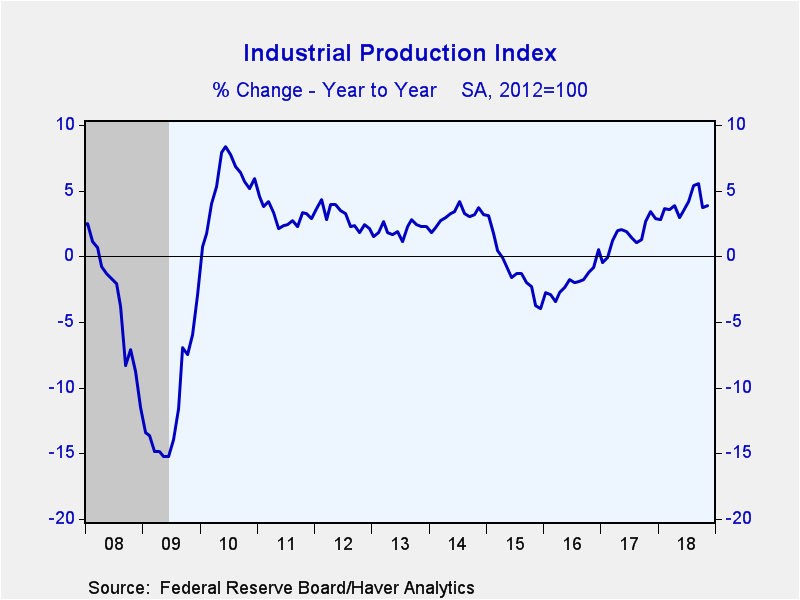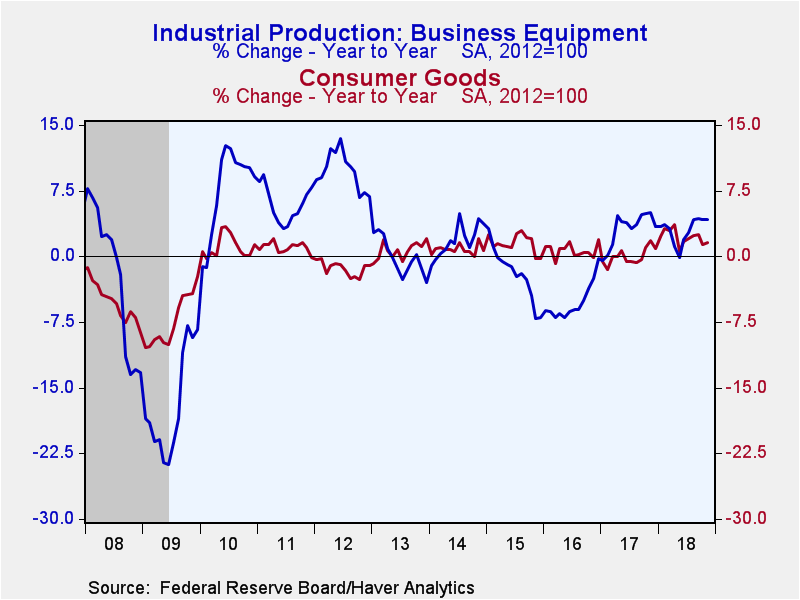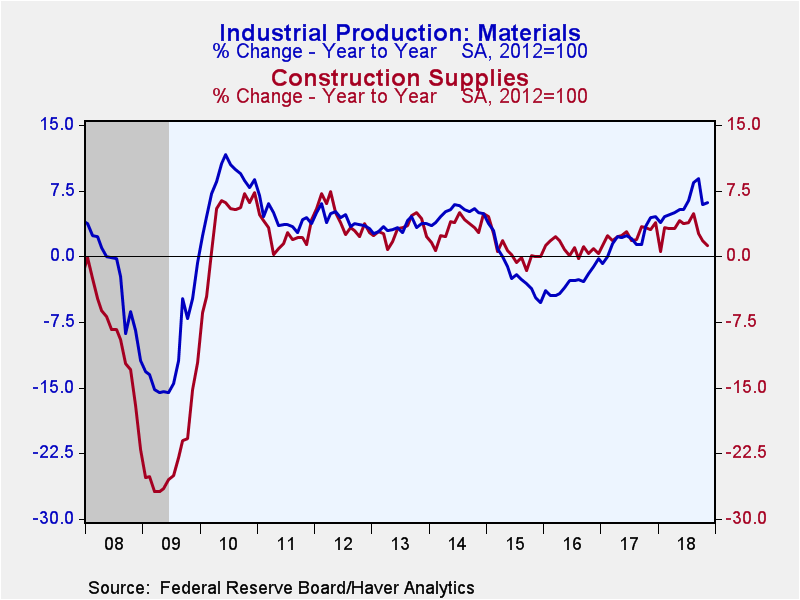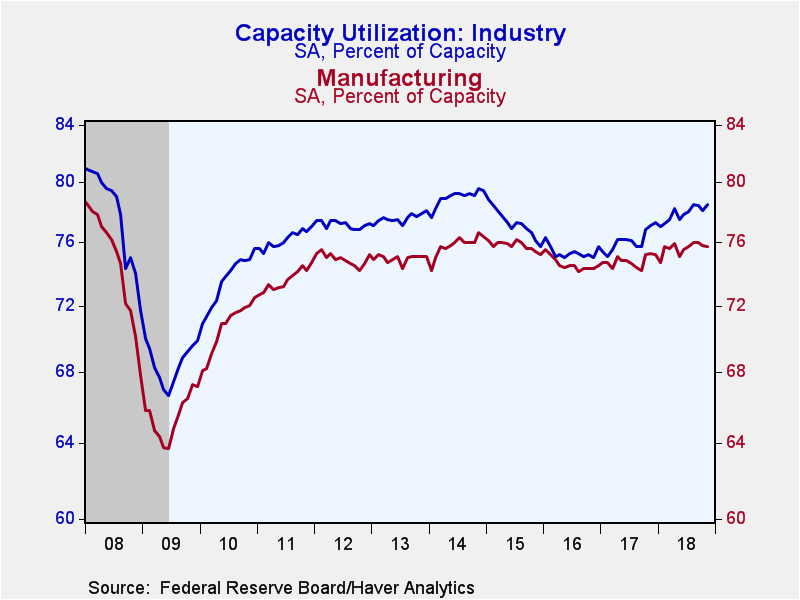 Global| Dec 14 2018
Global| Dec 14 2018U.S. Industrial Production Rebounds
Summary
Industrial production jumped a greater-than-expected 0.6% (3.9% year-on-year) during November following a downwardly revised 0.2% decline in October (was +0.1%). The 0.1% gain in September output was revised from 0.2%. The Action [...]
Industrial production jumped a greater-than-expected 0.6% (3.9% year-on-year) during November following a downwardly revised 0.2% decline in October (was +0.1%). The 0.1% gain in September output was revised from 0.2%. The Action Economics Survey forecast 0.3% growth in November. Manufacturing activity was unchanged (1.9% y/y) during November, while the two prior months were revised lower. Utilities output generated 3.3% (4.4% y/y) while mining production fired up 1.7% (13.2% y/y).
The flat reading in manufacturing belied offsets between durable goods (+0.2%; 3.7% y/y) and nondurables (-0.2%; +0.7% y/y). Durable goods production was bolstered by gains in machinery (0.5%; 6.2% y/y), motor vehicles (0.3%; 3.5% y/y), and computer output (0.2%; 5.1% y/y). Meanwhile, aerospace edged down 0.1% (+2.8% y/y). In the nondurable sector the 0.6% (+2.0% y/y) growth in chemical production was more than counterbalanced by declines in food (-0.5%; +1.1% y/y), petroleum and coal (-1.7%; -2.5% y/y), as well as printing (-1.0%; -1.7% y/y).
By market group, consumer goods output edged up 0.1% (1.5% y/y) in November. Meanwhile, business equipment declined 0.2% (+4.1% y/y) after strong gains in the previous three months. Construction supplies weakened 0.2% (+1.3% y/y), the third consecutive monthly decline. Production of materials jumped 1.2% (+6.1% y/y) as energy materials sizzled 2.3% (11.6% y/y).
In the special aggregate groupings, production of high technology products rebounded 1.6% (7.6% y/y) after two monthly declines. This was the result of strong gains in semiconductor & electronic components (2.1%; 10.1% y/y) and computer & office equipment (2.8%; 4.4 y/y). Factory sector production excluding the motor vehicle and high tech sectors edged down 0.1% (+1.6% y/y).
Capacity utilization increased to 78.5% in November, in line with the expectations from Action Economics Survey. Factory sector use edged down to 75.7%. Mining rebounded to 94.1%, near September’s business cycle high of 94.2%. Growth in capacity in the manufacturing sector continues to accelerate, up a cyclical high 1.3% y/y in November.
Industrial production and capacity data are included in Haver's USECON database, with additional detail in the IP database. The expectations figures come from the AS1REPNA database.
| Industrial Production (SA, % Change) | Nov | Oct | Sep | Nov Y/Y | 2017 | 2016 | 2015 |
|---|---|---|---|---|---|---|---|
| Total Output | 0.6 | -0.2 | 0.1 | 3.9 | 1.6 | -2.0 | -1.0 |
| Manufacturing | 0.0 | -0.1 | 0.2 | 1.9 | 1.2 | -0.8 | -0.6 |
| Consumer Goods | 0.1 | 0.0 | 0.2 | 1.5 | 0.0 | 0.7 | 1.5 |
| Business Equipment | -0.2 | 0.6 | 1.1 | 4.1 | 3.2 | -5.3 | -2.0 |
| Construction Supplies | -0.2 | -0.3 | -0.6 | 1.3 | 2.5 | 0.9 | 0.6 |
| Materials | 1.2 | -0.4 | 0.0 | 6.1 | 2.0 | -3.0 | -1.5 |
| Utilities | 3.3 | 0.2 | -1.2 | 4.4 | -1.3 | -0.4 | -0.8 |
| Mining | 1.7 | -0.7 | 0.6 | 13.2 | 6.4 | -9.7 | -3.4 |
| Capacity Utilization (%) | 78.5 | 78.1 | 78.4 | 77.1 | 76.1 | 75.4 | 77.3 |
| Manufacturing | 75.7 | 75.8 | 76.0 | 75.3 | 74.8 | 74.6 | 75.8 |
Gerald D. Cohen
AuthorMore in Author Profile »Gerald Cohen provides strategic vision and leadership of the translational economic research and policy initiatives at the Kenan Institute of Private Enterprise.
He has worked in both the public and private sectors focusing on the intersection between financial markets and economic fundamentals. He was a Senior Economist at Haver Analytics from January 2019 to February 2021. During the Obama Administration Gerald was Deputy Assistant Secretary for Macroeconomic Analysis at the U.S. Department of Treasury where he helped formulate and evaluate the impact of policy proposals on the U.S. economy. Prior to Treasury, he co-managed a global macro fund at Ziff Brothers Investments.
Gerald holds a bachelor’s of science from the Massachusetts Institute of Technology and a Ph.D. in Economics from Harvard University and is a contributing author to 30-Second Money as well as a co-author of Political Cycles and the Macroeconomy.









